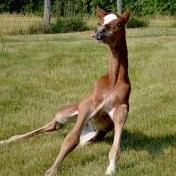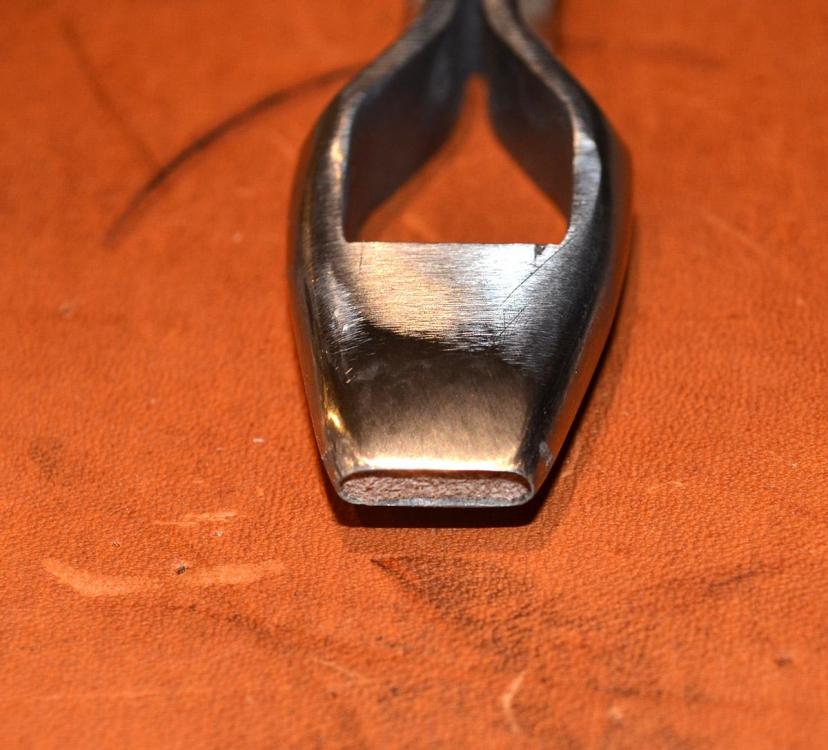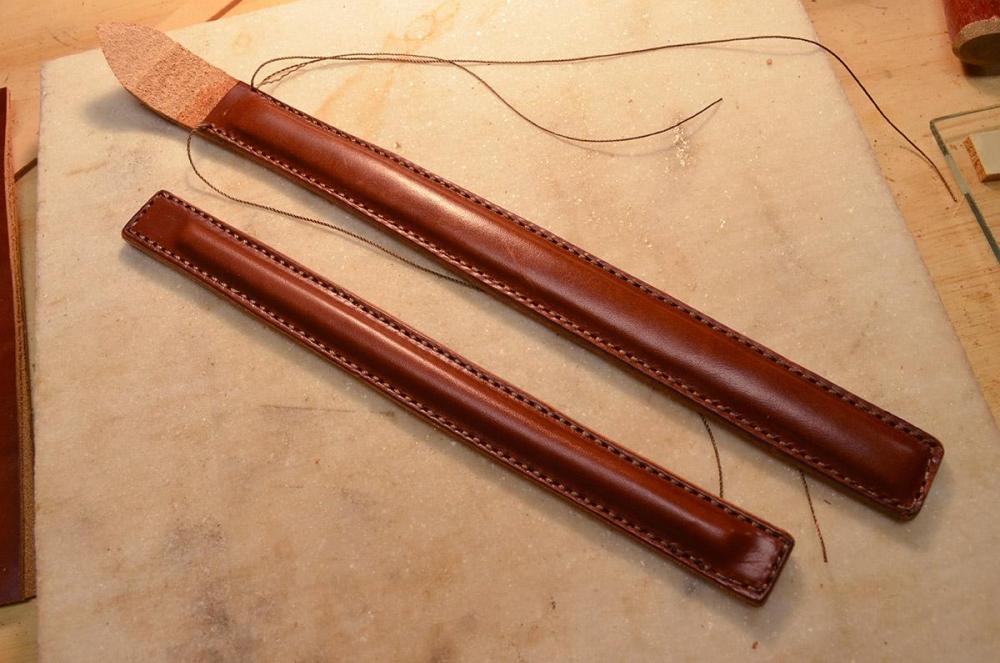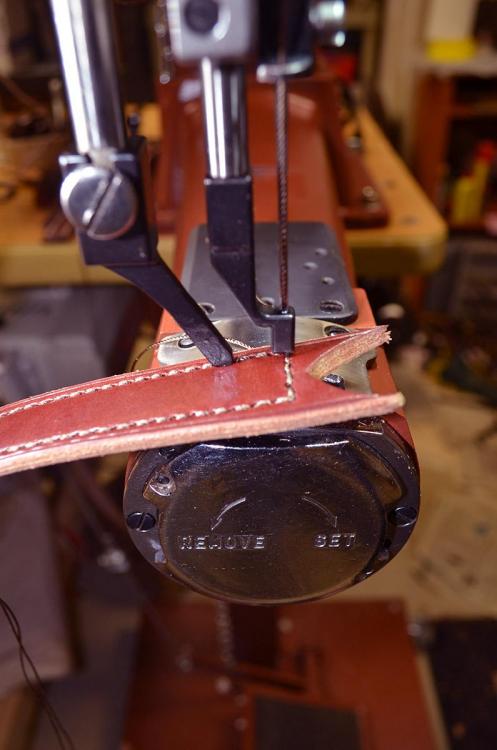-
Posts
1,284 -
Joined
-
Last visited
Content Type
Profiles
Forums
Events
Blogs
Gallery
Everything posted by TomE
-
Beautiful work! I'd need new spectacles for this realm. What is the tool used for creasing?
-
That's a work of art! Look forward to seeing more of your creations.
-
Nice work, @Klara and @Tugadude. It looks like that shape would be tricky to sew.
-
Thanks, @DJole and @Klara for the tip about Inkscape for vector drawings. Thinking about escaping the tyranny of the Adobe subscription. I mainly use Illustrator, Photoshop, Acrobat and Lightroom from this expensive package. Any recommendations for a less costly photo cataloging software?
-
I sharpen them by hand with oil stones, working the flat sides and rolling onto the ends. For this 1/2" Osborne punch, I spent some time with a coarse stone reshaping the flat sides then making a ~20 deg. bevel. The cutting edge remained flat and I didn't touch the inside. Worked the bevel with medium and fine oil stones, polished on a buffing wheel, and finished sharpening on a fine stone followed by stropping. Alternatively, you could hand sharpen by attaching wet/dry abrasive paper to a smooth surface like plate glass using 3M #77 spray adhesive. This punch isn't razor sharp but I am happy with it.
-
Good tip, @tsunkasapa. Been using my fingers but this sounds better.
-
Beautiful design and craftsmanship. At first glance it appears symmetric then I see all the asymmetries as I look more closely. Neat!
-

First project: rifle sling
TomE replied to Redbeeerd's topic in Gun Holsters, Rifle Slings and Knife Sheathes
Highly recommend Stohlman's book on hand sewing leather, and Neil Armitage videos. Using an awl will give you lots of flexibility in constructing and repairing items. -

First project: rifle sling
TomE replied to Redbeeerd's topic in Gun Holsters, Rifle Slings and Knife Sheathes
Looks like a very solid job on the strap. I can't see the thread along the edges but it looks like it is marked for sewing? That's an impressive varmint gun - a big upgrade from my .223 ranch rifle. Hope you enjoy leathercraft as much as I do. Lots of good folks with expertise on this site. -
I haven't used GIMP in a while, but I see it has a "Fuzzy Selection" tool that functions like the "Magic Wand" in Adobe Photoshop. The Magic Wand selects a group of pixels with similar color/intensity values from a contiguous area, or noncontiguous areas, enabling a background to be distinguished from artwork. The stringency of selecting "like" pixels can be changed to improve the selection. The invert selection command toggles between the magic wand selection and everything else (the artwork). Once the artwork is selected, an outline can be created by editing the selection to add "stroke" and "fill." I would guess that the GIMP has many of the same commands to work with the fuzzy selection tool. ADDED: Gabor Pinter wrote a 3 part article on "Digitalizing Patterns With Adobe Photoshop" in the 2022 March/April, May/June, and July/August issues of the Leather Crafters and Saddlers Journal. He is tracing the outline of a digital image using transparent layers and the brush tool in Photoshop.
-
I'm in the same boat, @DwightT. My patterns are strapwork with repeating curves that I find easiest to match/repeat using a vector graphics program. Also, I resize curved portions of the pattern to fit different horses. Used to run the GIMP on prehistoric UNIX machines back in the day. Impressive how far the GNU programs have come. Now I make patterns in Adobe Illustrator and print to PDF with scaling set to tiled, so I have a series of overlapping pages that can be taped together.
-
Beautiful work! Batz Corp sells stainless steel and brass trigger snaps that are a step up from zinc diecast, but maybe not with the slide for the elastic band.
-
Nice tip on using twine coated with rouge. Will give that a try for stropping inside the curve.
-
We've had great service from UPS in rural Missouri. Smaller packages shipped by an economy UPS rate are delivered by the USPS to our mailbox. Fedex or UPS (don't recall which) photographs the package on our doorstep. I'd try the help line again.
-
Vector graphics programs like Adobe Illustrator ($$$) and the GIMP (GNU Image Manipulation Program; free) are useful for line drawings, especially if you can't draw (like me).
-
https://www.springfieldleather.com/SLC-Pro-Beveler_3
-
The inline feet are listed among the accessories for the CB4500. https://www.tolindsewmach.com/cb-acc-pack.html
- 8 replies
-
- tack
- inline presser foot
-
(and 1 more)
Tagged with:
-
Thanks, Wiz. I'm fiddling with proportions and getting used to the look of the machine stitch but I think it's headed in the right direction. Thank you, Mulesaw. I still haven't worked out a method to machine sew swells that taper continuously to a thin edge. That might be a hand sew only option. Thanks for your encouragement!
- 8 replies
-
- tack
- inline presser foot
-
(and 1 more)
Tagged with:
-
Taking a break from hand sewing to practice machine sewing raised leather straps (again). Think I'm making progress with inline presser feet from @CowboyBob on my 441 clone. I've been able to sew tight to the raised filler and maintain a 1/8" border. Took me a while to adjust the presser foot timing to my liking, but now it's a quick change over between the inline feet and the regular center/side feet. Very happy with these compact feet for sewing tight to an edge. Took a little practice to smoothly back out of the corners, so that the rear foot has a place to land. The raised pieces are made from 2 pieces of bridle leather, split to 3 oz for the cover and 7 oz for the back. I use a veg tan filler piece 1/4" or 3/8" wide on these straps, and figure about 1/4" (2 x 1/8") of additional width for the cover wrapping around the sides of the filler. I glue the cover and shape it with a glass slicker and bone folder then sew and trim the edges before finishing the edges. I will use raised leather for bridle nosebands/browbands, dog collars, and belts. I've been sewing these by hand, but getting closer to production by machine sewing.
- 8 replies
-
- tack
- inline presser foot
-
(and 1 more)
Tagged with:
-
Those are pretty and nicely constructed collars, @BlackDragon. Well done. Was thinking the same for the handle. Stohlman's case making book Vol #2 describes this and other methods to attach handles. An alternative would be to sew a tab or shield on each end of the handle to distribute the load over a stitch line. A different look would be a rolled leather strap for the handle. I learned from the Stohlman book above and posted a summary here: https://www.leathercraftmasterclass.com/forum-1/leathercraft-techniques/rolled-leather-strap
-
With my manual splitter I pull the leather through at a constant downward angle to maintain a consistent split. I also keep an index finger next to the blade guard to keep the leather entering the blade from drifting upwards when approaching the end of the strap. I am typically splitting straps of 10 oz bridle leather to 5-7 oz thickness for liners and chapes. If the leather has uniform substance I can get an even split for 2-3 feet of length on a 1" strap. I don't know how your machine's feeding mechanism is configured but you might see if you can manually support the leather exiting the blade to maintain a consistent angle of feed.
-
The sweet spot for my hand splitter is with the blade aligned at the top/center of the roller up to 1/8" behind the center position. What type and weight of leather are you splitting? Does the split change in a continuous manner, becoming thicker or thinner along the length of the split, or is it moving up and down throughout the length of the split? Can you try something easy like splitting a firm 8-10 oz veg tan to half thickness?
-
Interesting design. No need to back out of corners as for the typical inline feet (?). Is the piece in the foreground made of 2 layers sewn together? Did you sew the bottom layer after stitching the layers together? I am interested in using inline feet to stitch tight against a raised leather feature. I can do it with the inline feet from Bob Kovar, which are quite nice, but I often sew raised leather pieces by hand in order to get closer to the raised edge and keep the border narrow.
-
Those are lovely straps to go with some eye-catching guitars.
-
I’ve had good luck with HO bridle leather. Nice finish, not too waxy, and uniformly good substance.

.jpg.d60258221c476480a6e073a8805645bb.jpg)




